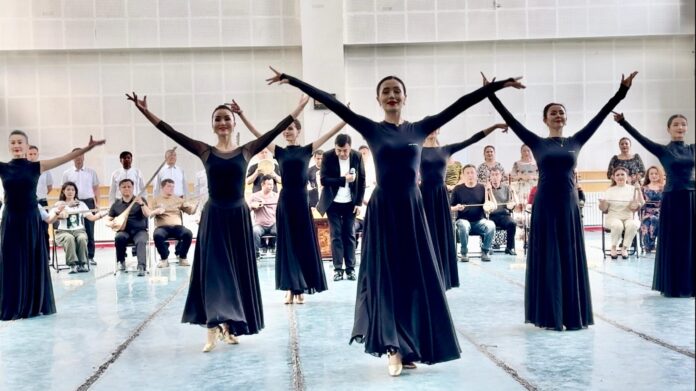A nation’s culture, livelihood, legacy, and history are its greatest assets. Any society’s sense of identity is derived from its culture and legacy, for both present and future generations.
Any civilization may retain its way of life, customs, traditions, values and history by promoting its culture and legacy. Culture is the strongest link that exists; it binds people together, helps them identify, enthralls them with art, and wins over hearts and minds.
The majority and minority populations in Xinjiang possess rich cultural values and artistic morality that the region’s government have perfected the skill of conserving and advancing. It is admirable how public funds have been allocated to preserve Uyghur culture.
A trip to the Muqam Art Theatre illustrates the importance Xinjiang places on projecting and advancing Uyghur culture. The theater presents Uyghur Muqam, a form of art that embodies the rich creative traditions of the Uyghur people.
As you approach the gate, a large sculpture depicting a well-known Uyghur musician performing on an instrument greets you. The statue’s placement in an orchard showcases the designer’s superior creative talent.
Entering the theatre, you will find yourself in a spacious auditorium where dancers were getting ready to captivate the audience with their mesmerizing creative traditional dances, while artisans with renowned Uyghur instruments were ready to perform well-known Uyghur melodies.
With its strategic location along the Old Silk Road, Xinjiang has served as a hub for East-West cultural interchange. As a result, important cultural traditions from other nations were also absorbed by Xinjiang culture, adding to its already vibrant art and culture, which is the foundation of civilization.
One of the largest ethnic groups in China, the Uyghur population, has a range of well-known songs and dances that are included in the Xinjiang Uyghur Muqam. Classical music in the style of Uyghur Muqam is distinguished by its varied content, distinctive instruments, choreography, and distinctive Uyghur dances.
The words of the songs, which are sung in solo and group settings and have varying rhyme and meter, are written by Uyghur poets and folk ballads.
Therefore, in order to strengthen the folk narrative and portray the history and contemporary way of life of the Uyghur people, the performances feature a broad variety of poetry, including poems and proverbs.
A visit to the Kazanqi Folk Tourism Area reveals yet another noteworthy aspect of the Xinjiang government’s preservation of the region’s legacy and culture. Located in the center of Yining City, Xinjiang’s Ili Autonomous Prefecture, lies Kazanqi Folk Tourism Area. Uyghurs, Han, Kazakh, Hui, Uzbek, Xibe, Manchu, Russian, Mongol, Tatar, Tajik, and Kyrgyz minority make up the local population.
Perhaps the clearest illustration of how a people can keep and practice its old culture is Kazanqi. Cleverly, old dwellings have been archived while occupants continue to live in them.
The government has provided the residents with alluring packages to support their way of life. Wandering around the streets, one may see ancient carts designed in the Tonga style and centuries-old infrastructure.
The residents provide food and shelter for the visitors and give them a taste of the centuries-old way of life in the houses that have been approved for use as guest houses. The homes are painted a certain color to uniquely represent each resident’s identity and the varied cultures found in the Kazanqi Tourism Area.
A five-year-old girl who was roaming through the streets of Kazanqi Tourism Area saw our team and willingly chose to welcome the delegates with a traditional Kazakh dance in accordance with the locals’ cultural values, demonstrating how deeply engaged the populace is with art and music.
To greet the group, a different homeowner of the house offered grapes from his yard. As the delegation was treated to a sumptuous lunch by a different landlord. The host’s abundant hospitality captured the hearts and thoughts of our delegation.
Due to a lack of emphasis, civilizations and languages are disappearing in the modern day. The influence of affluent nations and growing economies on economically weaker countries has been amplified by globalization. The situation has been made more difficult by wars and invasions of sovereign nations. As a result, cultures are either dying as a result of outside influences or are severely harmed and losing their vibrancy and uniqueness.
Language promotion and preservation are essential components of culture. The Xinjiang government is investing vast resources in the preservation and advancement of the Xibe language. In this context, promotion is being done for Qapgal News, the only Xibe-language newspaper in the entire globe.
The Xinjiang Autonomous Region’s preservation of the art and culture of the Xibe minority was another noteworthy aspect. There are 190,000 members of the Xibe ethnic group in China, which makes up a very small portion of the country’s overall population. Despite being over 700 kilometers away from Urumqi, the tiny Qapqal Xibe Autonomous County is treated as though it were the center of Xinjiang.
The publication is a reincarnation of Sulfan Jilgan, or Voice of Freedom, which was established in Yining District in 1946.
The publication was renamed as Ice Banjin (New Life News) in 1954. The newspaper was rebranded as Qapgal News in 1974. It is one of the fifty minority language publications that the Xinjiang Autonomous Region publishes. The newspaper is published four times a year in 100 issues, with an approximate distribution of 2,40,000 copies throughout Xinjiang.
The preservation of the locals’ traditional way of life in Qapqal Town was remarkable and exceptional. The elaborate murals adorning residence walls and the lavish grapevines draping across walkways seemed like visions fulfilled.
The people’s wonderful warmth and gracious welcome were a reflection of the county’s rich history and their strong sense of community.
The majority of the population is made up of Kazak tribal members who were moved to the area from six other villages in Qapqal Town as part of a 2013 central government initiative to reduce poverty.
The residents of the area are content and comfortable in their cosy new homes because their previous ones were vulnerable to natural disasters, had inadequate sanitary conditions, few transportation options, and few economic prospects. The Xinjiang government has committed RMB130 million in livelihood initiatives since the relocation started in 2013 so that the people may take advantage of a comfortable atmosphere, easy access to transportation, and infrastructure.
A dedicated attempt to maintain our legacy is essential to our cultural, educational, artistic, inspiring, and economic legacies—all of the things that essentially define who we are, as Steve Berry famously stated. In this sense, the extraordinary work that the Xinjian government has done in safeguarding and advancing the cultural legacy of its minorities is astounding. The rest of the world could imitate.





















